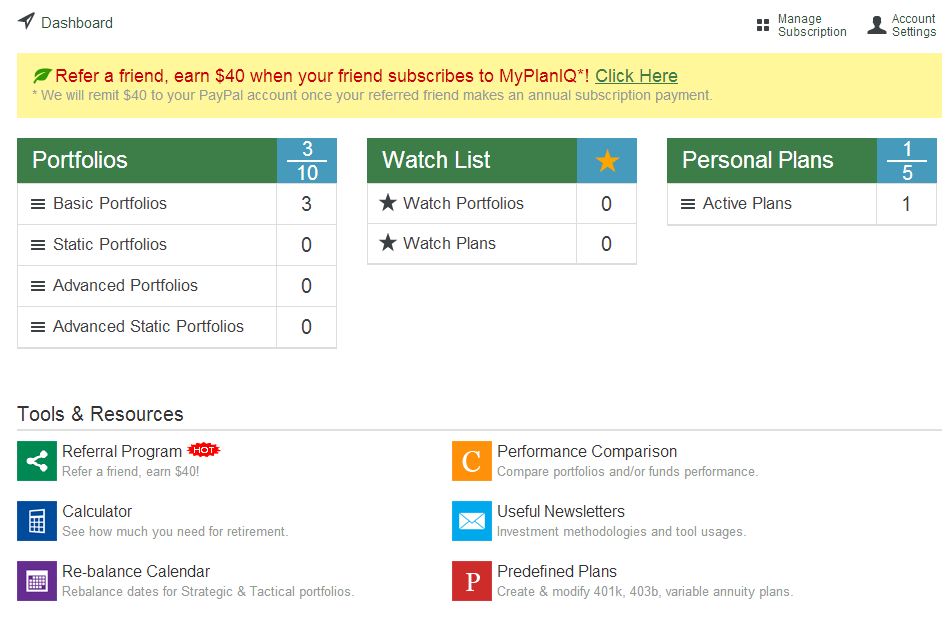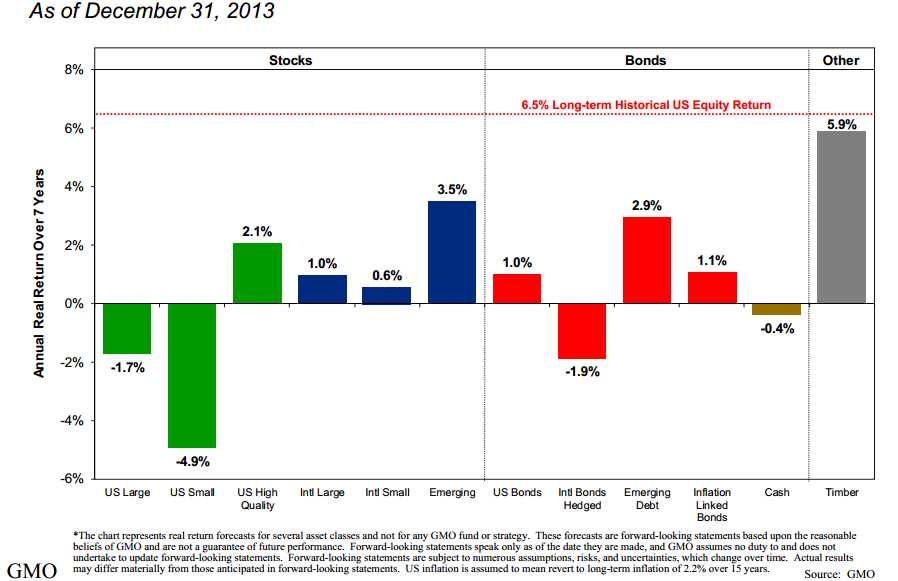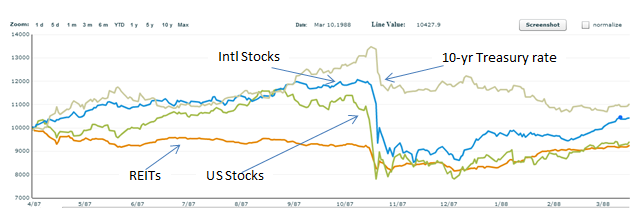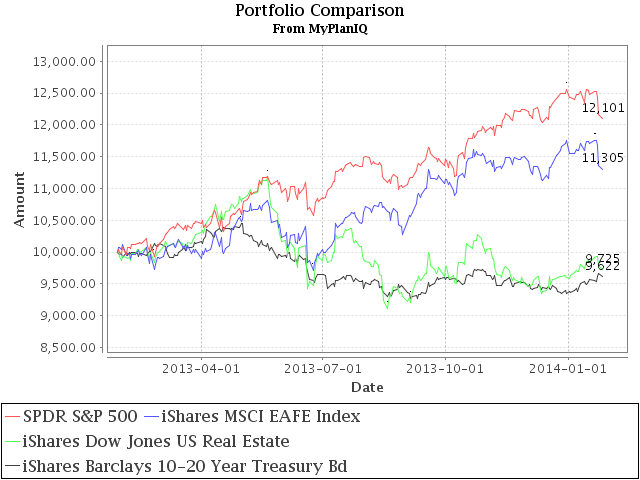Re-balance Cycle Reminder All MyPlanIQ’s newsletters are archived here.
For regular SAA and TAA portfolios, the next re-balance will be on Monday, February 18, 2014. You can also find the re-balance calendar for 2013 on ‘Dashboard‘ page once you log in.
As a reminder to expert users: advanced portfolios are still re-balanced based on their original re-balance schedules and they are not the same as those used in Strategic and Tactical Asset Allocation (SAA and TAA) portfolios of a plan.
Please note that we now list the next re-balance date on every portfolio page.
New Website And Features
We have released our latest change on our website. Here is a brief summary on what’s changed:
- Dashboard: we have completely revamped our dashboard. We have made portfolios and plans more prominent, along with many explanations and help documents.
- We have also added our popular compare tool to many places including portfolio pages, plan pages and various dashboard tables. We again encourage users to use this tool, especially pay more attention to year by year portfolio and fund metrics.
- We also changed our home page and our site to be more user friendly, oriented to types of investors instead of types of our features.
- We now also enable our support of flexible rebalance date in a month for expert users: now expert users can specify a date of month to rebalance instead of following our predefined system wide rebalance calendar.
Subscription Fee Change
We are changing our Basic Subscription fee to $19.95/month or $199.95/year, effectively on 3/15/2014. However, subscription plans initiated before the change will be unchanged indefinitely. That means for those of you who have subscribed or subscribe before 3/15/2014, your subscription fees will stay the same as long as you keep your subscription plan. There will be no change for expert or pro subscription fees.
What To Do In A Low Return Environment
Although ‘low return’ sounds like a very remote term to many investors these days, especially after stellar returns in the past 3 to 5 years. However, precisely because of the huge run-up of stock prices, we are now facing an increasingly difficult environment:
- Stocks are overvalued by many long term metrics: Shiller’s Cyclically Adjusted Price Earnings ratio (CAPE 10) (25.46) to its long term average (16.52) is 1.54. US stock market is 54% Over Value. Warren Buffett’s total stock market valuation over GNP stood at 126%. See Market Indicators for more details.
- Bonds have unusual low yields. There has been enough said in the media that bond yields can only go up from here from a long term perspective. A simple fact is that the last secular bull market in bonds have lasted for over 20 years and it is ending. We have seen bond prices have come down a bit but they are still elevated.
The above observation is for a long term 7-10 year time frames. Specifically, we quote the following latest GMO’s 7 year asset class forecast chart (go to GMO website and register a free account to get their latest asset class forecast):
- US stocks: ranging from negative to 2.1% annual return. Another data point is from Dr. Hussman’s weekly commentary: Hussman estimated that US stocks (S&P 500) will average about 2.7% annual total return in the coming 10 years.
- US bonds: 1% annual return in the 7 years.
- Even the highest emerging market stocks and emerging market bonds returns are dismal: 3.5% and 2.9% respectively.
What does this mean? That would mean a 60% US stocks and 40% US bonds ‘balanced’ portfolio represented by VBINX (Vanguard Balanced Index Inv) would achieve about 1.6% annual return. In an interesting article In Search of the Perfect Portfolio, published on the Wall Street Journal recently, it sounded a similar cautious tone on on the 60% stocks 40% bonds balance portfolios.
So what to do in such a low return environment?
We offer the following suggestions:
- Lower your expectation: this is especially true for a strategic buy and hold portfolio. Even for a globally diversified portfolio such as our Six Core Asset ETFs Strategic Asset Allocation – Equal Weight Moderate (incidentally, in the above Wall Street Journal article, equal weighted allocation was suggested by several experts) that has emerging market stocks and commodities exposure, based on GMO’s outlook, one shouldn’t expect too much higher returns. An average 3% annual return might be already an optimistic expectation.
- More tactical: as we pointed out many times, we believe all strategies have their own cycles (see October 8, 2012: Asset Allocation Strategies Have Cycles Too, December 10, 2012: How Asset Allocation Strategies Performed In Secular Market Trends). Strategic allocation has done for the past 3 and 5 years and as markets are becoming more and more expensive, the tide will turn and tactical will start to out perform again.
- More tactical is also true even in the fixed income investing: for many retirees or conservative investors, taking advantage of pockets of strength at various market cycles in bond segments such as high yields, emerging market bonds, inflation protected bonds and even long term bonds is one possible way to enhance returns without increasing much risk.
We would also emphasize that a low return environment is a more dangerous environment. When markets are substantially lower, a high return environment will emerge and it will be much safer to invest. So again, regardless of what strategies (strategic or tactical) you are using, it is important to adjust your overall allocation to a risk level you are comfortable right now.
Market Overview
Stocks have experienced a non-stop 3 day drop. This might or might not become a full blown correction or even a crash. However, we are very cautions on the current mini-crash. We would like to draw your attention to the chart we showed in our previous newsletter October 28, 2013: What Can We Learn From The 1987 Stock Market Crash?:
Compared this with
Notice that we are using the total return of TLH (10-20 year Treasury bonds ETF) instead of the yields in the above chart so it is better to view this chart as an inverse instead. Current situation does possess some of similarity to that in 1987.
The above by no means is a forecast. What we try to convey here is again: markets are more precarious than most would think and thus, we call for cautions again.
Regarding asset class trends, we can see bonds continue to their favorable trends: the 10 year and 20+ year Treasury bonds have positive 13 and 26 weeks trend scores now. This is yet another confirmation with the general bond up trend.
For more detailed asset trend scores, please refer to 360° Market Overview.
We would like to remind our readers that markets are more precarious now than other times in the last 5 years. It is a good time and imperative to adjust to a risk level you are comfortable with right now. However, recognizing our deficiency to predict the markets, we will stay on course.
We again copy our position statements (from previous newsletters):
Our position has not changed: We still maintain our cautious attitude to the recent stock market strength. Again, we have not seen any meaningful or substantial structural change in the U.S., European and emerging market economies. However, we will let markets sort this out and will try to take advantage over its irrational behavior if it is possible.
We again would like to stress for any new investor and new money, the best way to step into this kind of markets is through dollar cost average (DCA), i.e. invest and/or follow a model portfolio in several phases (such as 2 or 3 months) instead of the whole sum at one shot.
Latest Articles
- Optimal Allocation Between Stocks and Bonds
- What would Keynes have done?
- The portfolio rebalancing act: Feels bad, works good
- It’s Different This Time for Tech Stock Valuation
- Equal Weight S&P 500 Is Bettering S&P 500 Again!
- January 20, 2014: Become an Enlightened Investor
- Should We Wallow in the Rising Stock Market?
Enjoy Newsletter
How can we improve this newsletter? Please take our survey
–Thanks to those who have already contributed — we appreciate it.






 Diversified Asset Allocation Portfolios For Your Plans
Diversified Asset Allocation Portfolios For Your Plans
